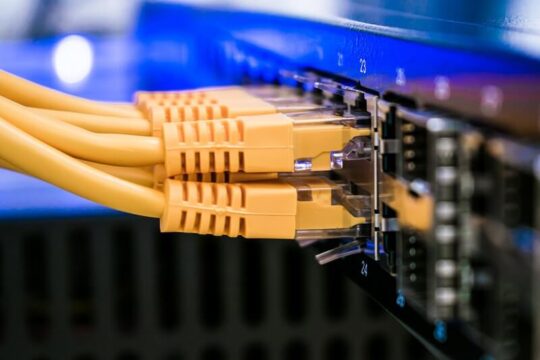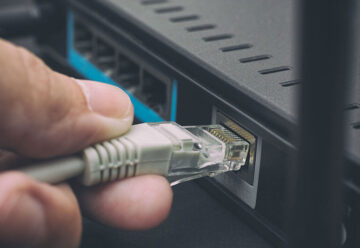- What is Carrier Ethernet?
- How does Carrier Ethernet differ from traditional Ethernet?
- Types of Carrier Ethernet services
- How does Carrier Ethernet work?
- Carrier Ethernet vs Metro Ethernet: what’s the difference?
- What are the benefits of Carrier Ethernet for businesses?
- Who uses Carrier Ethernet?
- Carrier Ethernet solutions
What is Carrier Ethernet?
Carrier Ethernet is a network service that extends Ethernet technology beyond local area networks (LANs), allowing businesses to connect one or more sites over long distances. Typically used to build wide area networks (WANs), it provides high capacity Ethernet connectivity between geographically dispersed locations, such as branch offices, data centres or cloud service providers.
How does Carrier Ethernet differ from traditional Ethernet?
While Carrier Ethernet and traditional Ethernet both rely on Ethernet protocols, traditional Ethernet is designed to connect devices within a single site, such as an office or campus. By contrast, Carrier Ethernet uses a network service provider’s managed infrastructure to connect one or more sites, often over greater distances or across geographically dispersed locations.
Here’s a breakdown of the key differences:
Ethernet vs Carrier Ethernet
| Traditional Ethernet | Carrier Ethernet | |
| Geography | Connects devices within your local area network (LAN) | Connects one or more geographically dispersed business sites via a service provider |
| Management | Managed internally by your IT team | Fully managed service with monitoring and SLAs |
| Distance | Limited to a single site, like an office or campus | Suitable for metro, regional, or geographically dispersed links |
| Delivery | Runs over your internal cabling and hardware | Delivered via a provider’s managed infrastructure |
| Speed | Typically up to 1Gbps, though higher LAN speeds (e.g. 10Gbps) are possible | Often supports 1Gbps to 100Gbps, depending on the service |
| Scalability | Limited by your existing LAN infrastructure | Easily scalable to meet growing bandwidth demands |
| Resilience | Depends on your on-site setup | Built-in redundancy and carrier-grade fault tolerance |
| Standards | IEEE Ethernet standards (e.g. 802.3) | IEEE Ethernet standards plus Metro Ethernet Forum (MEF) specifications |
| Typical uses | Connecting computers, printers and servers on-site | Linking branch offices, data centres or cloud services |
Types of Carrier Ethernet services
Carrier Ethernet is a collection of service types standardised by the Metro Ethernet Forum (MEF) to meet different business needs. Here are the main service types for end-user subscribers.
E-Line (point-to-point or point-to-multipoint)
The most common Carrier Ethernet service, E-Line, provides a dedicated point-to-point (P2P) connection between two sites. Also known as Ethernet Private Line (EPL), it provides a P2P Ethernet Virtual Connection (EVC) between a pair of user network interfaces (UNIs). It’s ideal for businesses that need a secure, high-capacity link between two fixed locations.
E-Line (P2P)
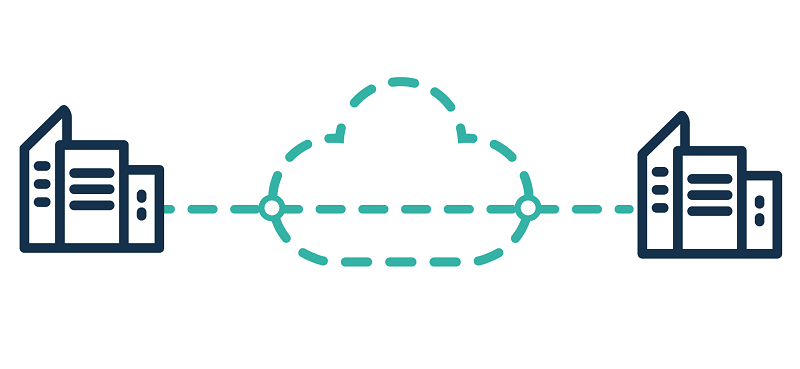
If you want to connect multiple sites, you can use E-Line in Ethernet Virtual Private Line (EVPL) configuration. EVPL supports point-to-multipoint (P2MP) connectivity by enabling multiple EVCs per UNI.
E-Line (P2MP)
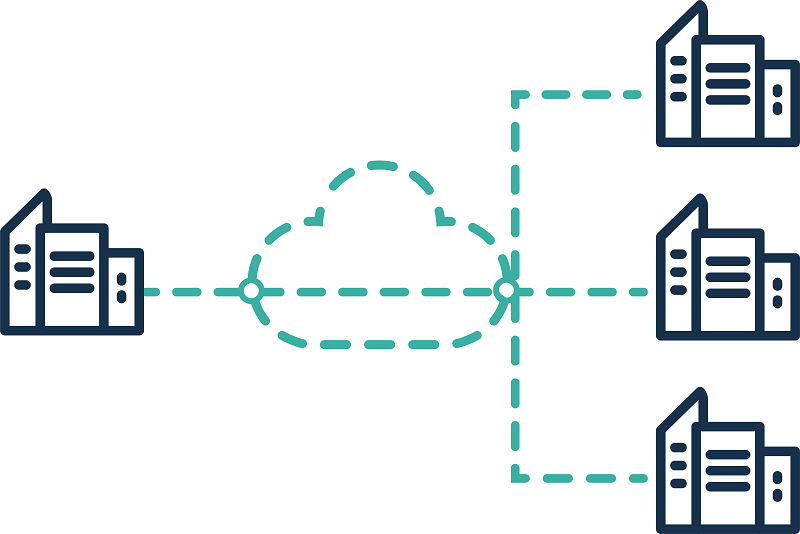
E-LAN (multipoint-to-multipoint)
Enabling any-to-any connectivity, E-LAN, also known as Ethernet Virtual Private LAN, is the carrier equivalent of Virtual Private LAN Service (VPLS). E-LAN allows three or more sites to exchange data directly with each other. This is suitable for organisations with distributed branches requiring consistent performance between sites.
E-LAN
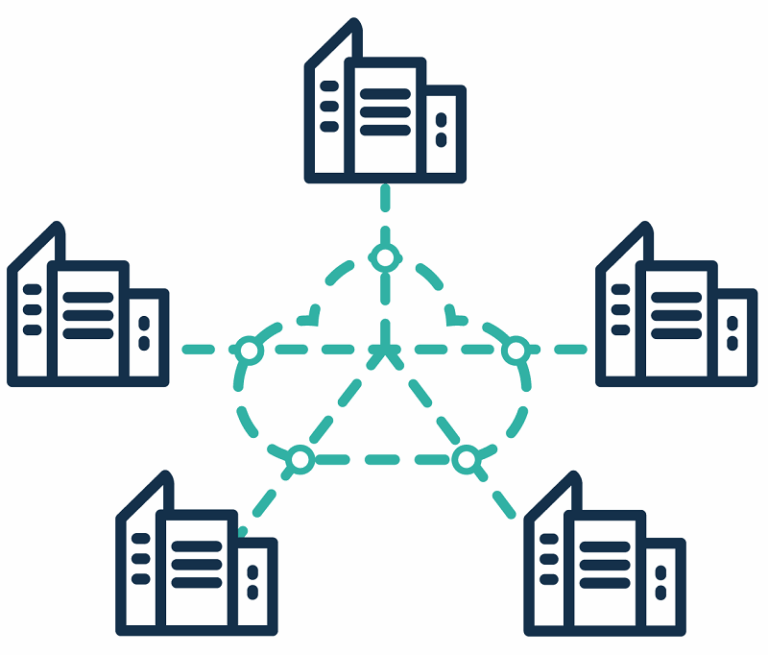
E-Tree (rooted-multipoint/hub-and-spoke)
E-Tree connects a central site to multiple sites, but the “leaves” (branch nodes) of the tree don’t exchange data directly. It’s commonly used in scenarios that require point-to-multipoint (P2MP) connectivity with strict traffic separation, such as data centre, enterprise and service provider networks.
E-Tree
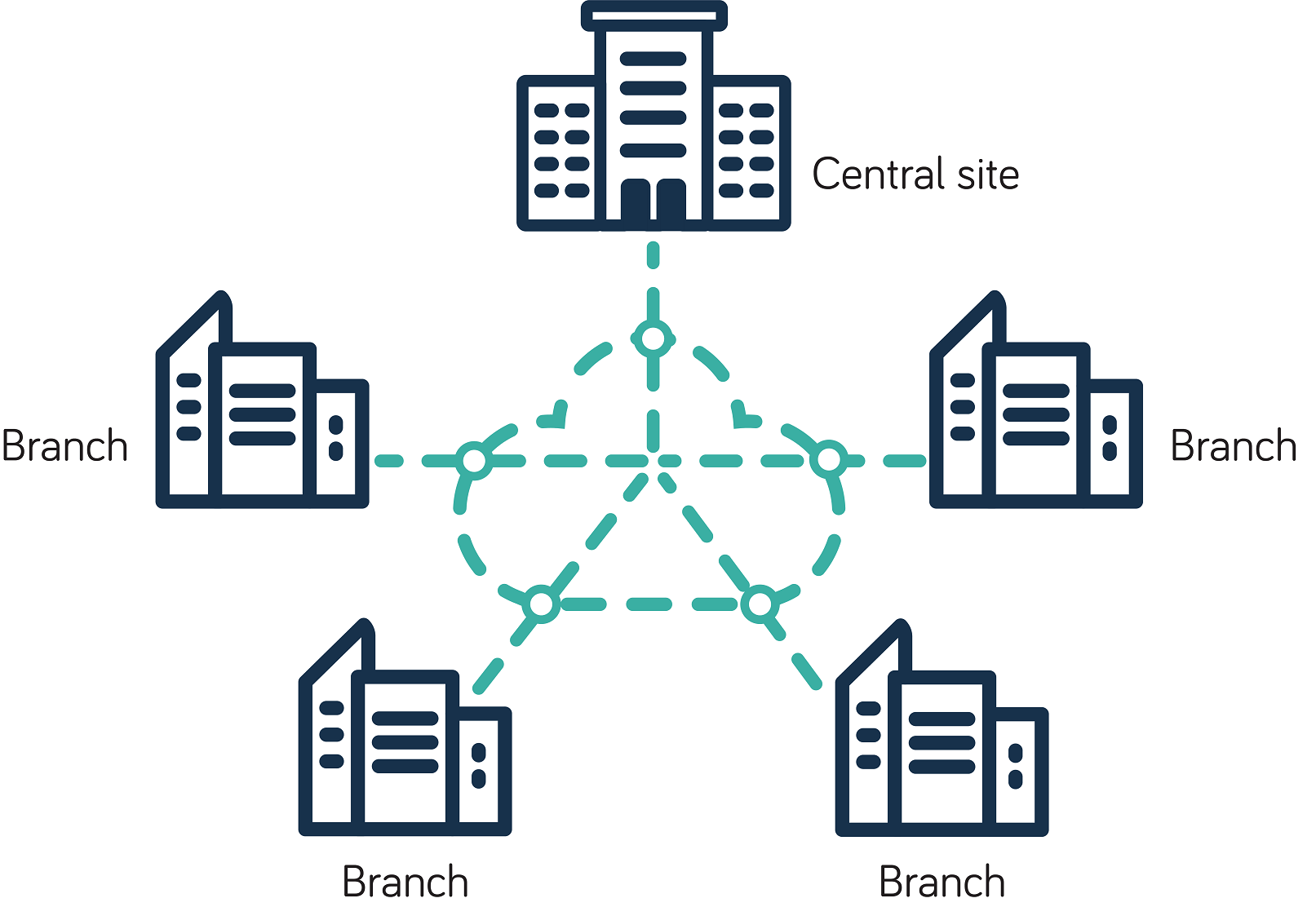
E-Access (network-to-network)
Designed for service providers, E-Access provides a local access connection to another carrier’s network via an external network-to-network interface (NNI). If you’re a service provider, it enables you to extend Ethernet services beyond your own footprint, for example, to reach off-net customer locations in last-mile scenarios.
E-Access
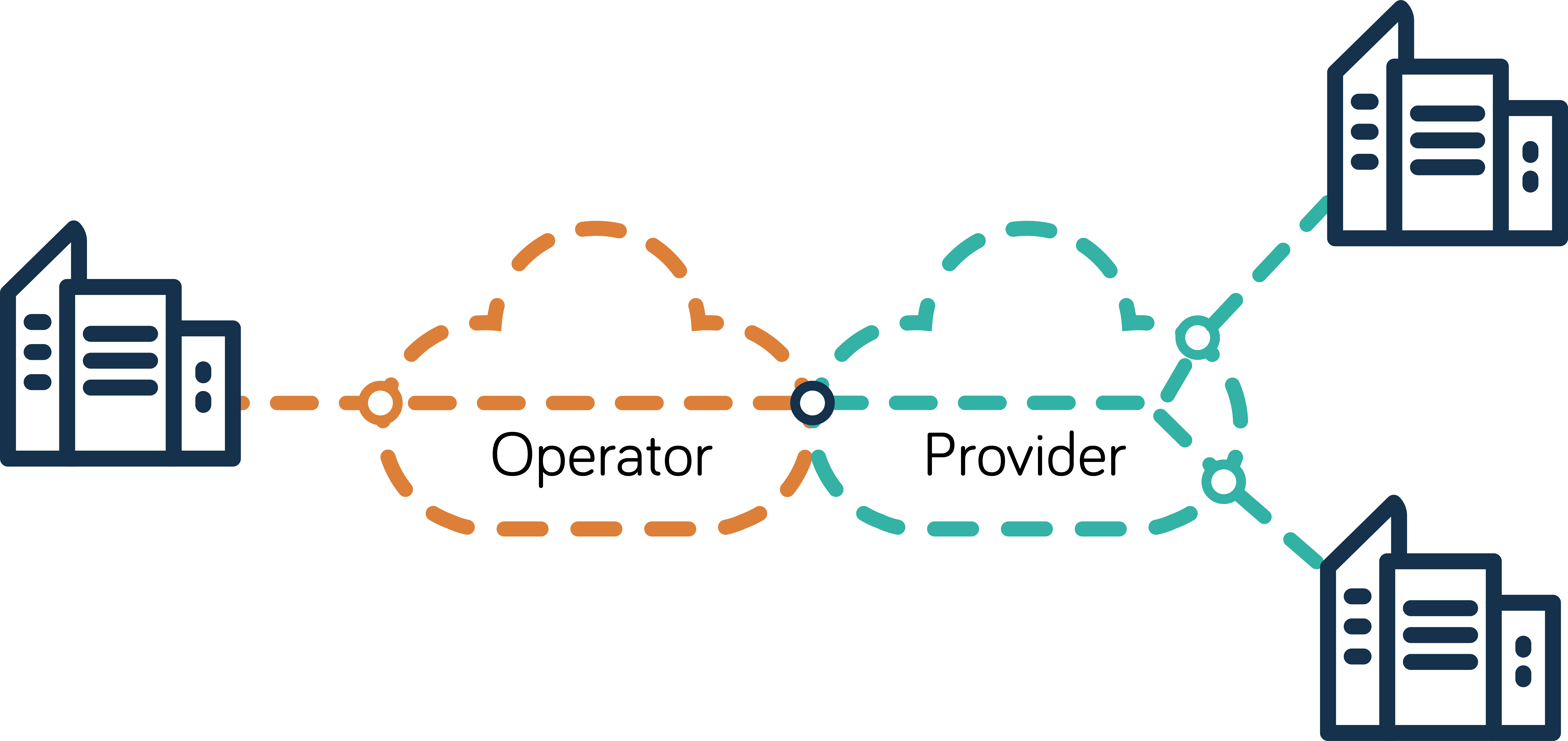
For instance, at Neos Networks we provide point-to-NNI (P2NNI) E-Access connectivity, enabling you to connect multiple sites back to your network as efficiently as possible.
A subset of E-Access, Transit E-Access, allows a network service provider to hand off traffic to another operator without using an external NNI.
How does Carrier Ethernet work?
Carrier Ethernet works by using standard Ethernet protocols to deliver high capacity connectivity over a telecom provider’s managed network. It combines Ethernet with carrier-grade standards to ensure scalability, reliability and Quality of Service over longer distances.
Carrier Ethernet standards
First standardised in 1983 as IEEE 802.3, Ethernet initially used coaxial cables to transmit data at a maximum of 10Mbps across LANs up to around 500m. As demand for Ethernet-style simplicity grew beyond local area networks, service providers began delivering Ethernet over fibre networks in a metropolitan area, a model known as Metro Ethernet.
Founded in 2001, the Metro Ethernet Forum (MEF) introduced a set of global standards for Metro Ethernet. In time, these evolved into Carrier Ethernet, which delivers high-bandwidth data transmission over longer distances – regional, national or international wide area networks.
Building on IEEE Ethernet standards, Carrier Ethernet adds MEF-defined features, including:
- Standard service types like E-Line, E-LAN, E-Tree and E-Access
- Guidelines for traffic management to ensure Quality of Service
- Operations, Administration and Maintenance (OAM) standards for fault management and performance monitoring
- Service-level agreements (SLAs) to ensure performance, uptime and support
These standards ensure Carrier Ethernet delivers the scalability and reliability needed for business-critical networks, whether connecting sites within a city or across regions and countries.
Carrier Ethernet vs Metro Ethernet: what’s the difference?
Put simply, Metro Ethernet refers to Ethernet services delivered within a metropolitan area, while Carrier Ethernet supports Ethernet connectivity across larger networks, with added scalability and service assurance.
Metro Ethernet can be delivered using proprietary technologies or based on MEF Carrier Ethernet standards. When delivered to MEF specifications, it’s a subset of Carrier Ethernet, offering the same performance, scalability and interoperability over a metropolitan area network (MAN).
Here’s a summary of how they differ:
Metro Ethernet vs Carrier Ethernet
| Metro Ethernet | Carrier Ethernet | |
| Geography | Typically limited to a metropolitan area | Designed for metropolitan, regional, national or international networks |
| Service types | Can support MEF-defined services like E-Line and E-LAN | Always supports MEF-defined service types |
| Scalability | Scalable for local or metro-scale connectivity | Highly scalable to support wholesale and multi-site enterprise networks |
| Management | MEF-compliant services may include SLAs and monitoring | Managed service with SLAs, performance guarantees and OAM |
| Interoperability | May be limited if proprietary; MEF-compliant networks support interoperability | Designed for full multi-vendor, multi-operator interoperability |
| Typical uses | Connecting sites within a metropolitan area or city-wide campus | Connecting sites across cities, regions or countries |
While both Metro Ethernet and Carrier Ethernet support high-speed connectivity, Carrier Ethernet offers greater scalability. It supports higher bandwidths, wider geographic reach and more advanced service options for large-scale enterprise and wholesale use.
What are the benefits of Carrier Ethernet for businesses?
Whether you’re connecting two locations or building a multi-site network, Carrier Ethernet offers a high-performance, cost-effective alternative to legacy WAN technologies. Here are some of its key advantages:
- High bandwidth: Scalable speeds from 10Mbps to 100Gbps
- Scalability: Easy to add bandwidth or connect new sites as you grow
- Flexibility: Supports point-to-point, multipoint and hybrid network topologies
- Cost efficiency: Typically lower cost than traditional WAN technologies like MPLS or leased lines
- Reliability: Built-in redundancy, Quality of Service guarantees and SLAs for uptime and performance
- Interoperability: Based on open standards that support integration across providers, networks and equipment vendors.
From large enterprises to public sector bodies, many organisations use Carrier Ethernet to support mission-critical connectivity across multiple sites.
Who uses Carrier Ethernet?
A wide variety of sectors rely on Carrier Ethernet to connect locations and users with consistent performance. Typical users include:
- Enterprises: connecting branch offices, data centres and cloud services
- Service providers: extending reach and delivering managed Ethernet services
- Retail chains: linking stores, warehouses and payment systems
- Media companies: transmitting live video across production and post-production sites
- Financial services: enabling secure, low latency connectivity between offices, data centres and trading environments
- Public sector: supporting secure, private networks for health care, education, local authorities and government departments
Whether supporting core business systems, cloud access or remote site connectivity, Carrier Ethernet underpins a wide range of business-critical networks.
Carrier Ethernet solutions
At Neos Networks, we deliver high capacity, fully managed Carrier Ethernet services designed for your business across our extensive UK-wide fibre network. Our Business Ethernet solutions are scalable, resilient and backed by stringent SLAs – built to support your most business-critical operations.
Speak to one of our experts to discuss your options. Whether you’re looking to connect data centres, branch offices or dispersed sites, we’ll be happy to make Ethernet work for you.
Speak to an expert
Carrier Ethernet FAQs
-
Is Carrier Ethernet secure?
Yes, Carrier Ethernet services are typically delivered over dedicated connections operating in Layer 2 (Data Link Layer) of the OSI model. That means they’re physically separate from the public internet, making them highly secure for sensitive business data.
-
Can you use Carrier Ethernet to access the internet?
Yes, Carrier Ethernet can be used to deliver Dedicated Internet Access (DIA), a private, high-speed, uncontended connection between your premises and the internet.
-
How does Carrier Ethernet compare to MPLS?
Carrier Ethernet is a Layer 2 service providing high capacity, point-to-point or multipoint Ethernet connectivity over a managed service provider network. In contrast, MPLS (Multiprotocol Label Switching) operates between Layers 2 and 3 (Data Link and Network layers) and routes data using labels rather than traditional IP addressing. Carrier Ethernet is a simpler, cost-effective solution for high-performance site-to-site connectivity, while MPLS is better for larger or more complex networks requiring advanced traffic engineering and routing. However, providers may use MPLS in their core networks to help transport Carrier Ethernet services across longer distances or between dispersed sites.
-
Does Carrier Ethernet support Quality of Service (QoS)
Yes, Carrier Ethernet supports QoS, allowing you to prioritise traffic to ensure consistent performance for your critical services. However, MPLS typically offers more advanced QoS with more granular control over traffic classes and routing for more complex, large-scale networks.
